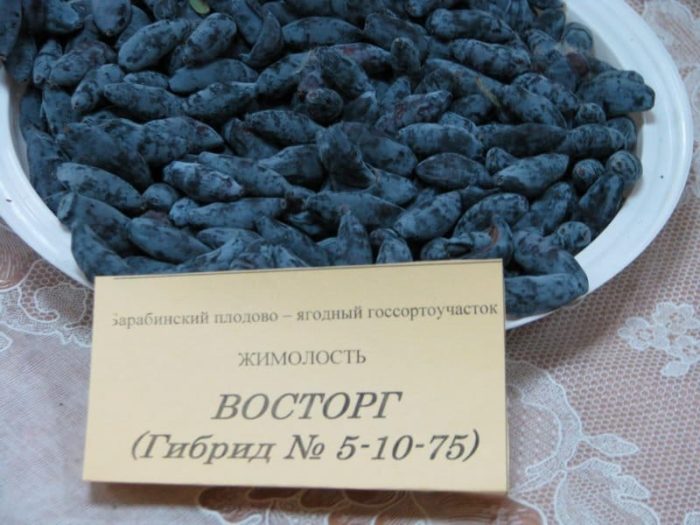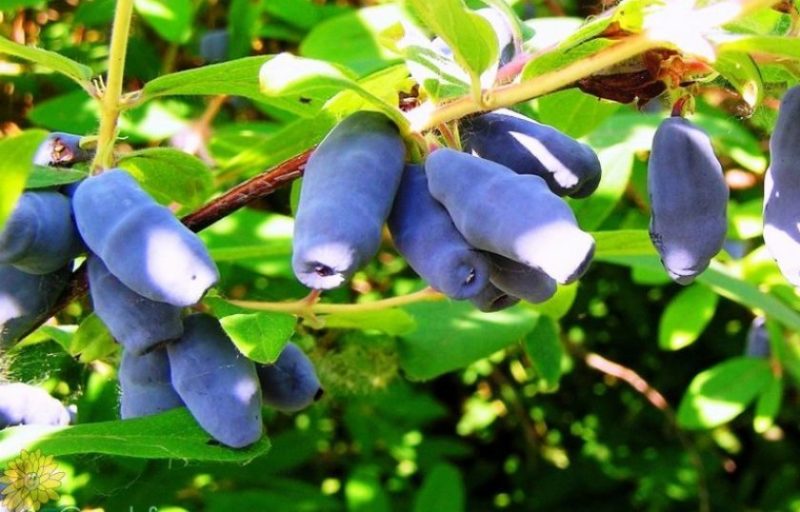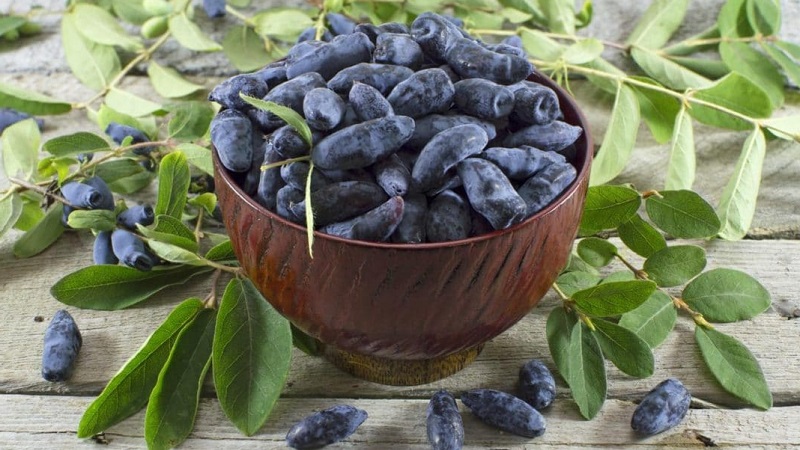Unpretentious frost-resistant honeysuckle variety Delight
Honeysuckle Delight is loved by gardeners due to its frost resistance, unpretentiousness to care and soil composition, large fruit, and long-term stable fruiting. These are not all the advantages of the variety, while it has practically no disadvantages. Let's take a closer look at how to plant bushes correctly in order to enjoy a harvest of delicious berries for a long time.
Description of the honeysuckle variety Delight
This is an edible variety bred by Russian breeders. 100 g of Delight fruits contain 8.5% sugar, 2.6% acid and 52.6 mg/% vitamin C. The berries are useful for people with anemia and sore throat, they help strengthen the immune system, have anti-inflammatory and antibacterial properties.

Origin and development
The variety was bred at the Federal State Unitary Enterprise "Bakcharskoe" by breeders N.V. Savinkova and A.V. Gagarkin. Honeysuckle Vostorg entered the State Variety Testing in 2012 and was included in the State Register of Russia in 2020.
Characteristics, appearance, taste
The bushes are medium-sized, 1.7–1.9 m high, with a rounded crown reaching 1–1.5 m in diameter. The shoots are hairless, straight, light green in color, old branches are slightly curved at the base, brown.
The leaves are green, waxy in texture, arranged oppositely, oval in shape, reaching 3–8 cm in length and 1–3 cm in width. The leaf blades are matte, leathery, smooth, concave. During flowering (in March), yellow-white flowers 1.2–1.6 cm long appear in the axils and at the ends of the branches.
The berries are spindle-shaped or pod-shaped, large in pairs (length - 3-4 cm, diameter of the wide part - up to 1.5 cm), weigh 1.4-3 g, covered with a thin, rich blue skin with a waxy coating.
The taste is dessert, sweet and sour, without astringency or bitterness, reminiscent of blueberries and blueberries with a hint of black currant. Tasting score: 4.8 out of 5 points.
Features of application
The berries of this honeysuckle variety are consumed fresh, frozen, ground with sugar, and used to make preserves, jellies, marmalade, and juices.
Ripening period, yield and fruiting
This is an early ripening variety of honeysuckle: berries mature approximately 70 days after pollination (late May - early June).
Reference. The average yield of Delight is 32.7 c/ha.
The bushes begin to bear fruit at 3 years old, at which time 1.3–2.5 kg of berries are harvested from each. Honeysuckle reaches its maximum yield at 6–15 years of age—up to 5.5 kg of fruit ripens on each bush.
Resistance to diseases and pests
The variety has good immunity. However, as a result of violation of agrotechnical requirements or infection from other plants, it can be affected by aphids, mites, scale insects, fingerwings, leaf-eating insects (sawfly caterpillar, miner larvae and fox moths), powdery mildew, cercospora blight, ramulariasis and rhea mosaic virus.
Resistance to cold and drought
Delight bushes can withstand air temperatures down to -40°C and tolerate return frosts down to -8°C.
Lack of moisture leads to a decrease in yield and negatively affects the taste of the berries - they become sour and bitter. At the same time, excessive moisture and waterlogging of the soil provoke rotting of the root system and the development of fungal diseases.
Suitable regions and climate requirements
The variety is included in the State Register of Russia with permission for cultivation in the West Siberian region, but due to its high frost resistance and unpretentiousness to weather conditions, it is successfully cultivated in other areas. Difficulties in growing Delight can only arise in northwestern European regions with a mild and humid climate.
Advantages and disadvantages of the variety

The main benefits of Honeysuckle Delight:
- large fruit;
- early ripeness;
- uniform ripening of the crop;
- frost resistance;
- possibility of universal use of fruits;
- precociousness;
- good immunity to diseases and pests (subject to compliance with agricultural technology);
- long and regular fruiting.
Among the disadvantages of the variety are the tendency to shed fruits and the need for pollinators.
Difference from other varieties and hybrids
A comparison of Delight with other early ripening honeysuckle varieties is presented in the table.
| Variety | Average weight of berries, g | Taste | Fruit color | Productivity, kg/bush |
| Delight | 1,4–3 | Sweet and sour, without bitterness or astringency | Deep blue | Up to 5.5 |
| Assol | 1,1–1,5 | Sweet and sour | Dark purple | 2,5 |
| Titmouse | 0,8–1 | Black | 5–7 | |
| Sweet tooth | 1–1,5 | Sweet | Blue | Up to 4 |
Agricultural technology
This variety does not have any special requirements for planting and care. The main thing is to choose the right planting site and comply with the standard agrotechnical requirements of the crop.
Choosing a place in the garden and preparing holes
For planting, choose a well-lit place, protected from gusty winds and drafts. The permissible groundwater level is 1–1.5 m.
Lack of light leads to a lack of flowering and a set of green mass; the berries are formed smaller and more sour and ripen more slowly.
Preparing for landing
It is advisable to take 2-3-year-old seedlings 30–35 cm high with 2-3 shoots, a root collar 1 cm thick and wet roots 20–25 cm long without signs of disease, rot or damage.
Reference. Roots longer than 30 cm are shortened by 5–10 cm before planting.
For planting material with a closed root system, the earthen ball should be moist and penetrated with small roots.
Soil requirements
Honeysuckle Delight prefers light, loose soil enriched with organic fertilizers with good aeration, moisture permeability and a neutral or medium level of acidity. The best option is light sandstones or medium loams.
Dates, scheme and rules of planting
Planting is carried out in early spring (March) or late autumn (late October - early November). In Siberia, autumn planting occurs at the end of September - beginning of October. Seedlings with a closed root system are planted throughout the year, with the exception of too hot weather and frost.
Landing rules:
- In the selected area, dig planting holes 40–50 cm deep and 60–70 cm wide every 1.3–2 m.
- Place a drainage layer of stones, plant branches, and bark at the bottom of each hole.
- Mix the excavated soil with 20 kg of compost, 1 liter of wood ash and 3 tbsp. l. superphosphate. Pour the resulting soil mixture into the holes and form a hill.
- Place a seedling in the center of the hill, spread its roots along the slopes, cover it with soil so that the root collar is buried a maximum of 5-6 cm.
- Water the plant and mulch the tree trunk.
The optimal distance between rows is 2.5–3 m for private cultivation and 4 m for industrial cultivation.
Features of cultivation
When watering honeysuckle, they are guided by weather conditions and the condition of the soil - it should not be allowed to dry out or become waterlogged. In the absence of rain, the bushes are watered 1-2 times every 14 days.
After watering, the soil is loosened to improve its moisture and breathability. An organic layer of mulch 5–7 cm thick retains moisture in the soil, prevents the growth of weeds, and in the fall protects the roots from frost.
Feed plants begin 3 years after planting. In the spring, apply compost, humus or low-nitrogen fertilizers to stimulate flowering and enrich the soil with nutrients. At the end of autumn, a layer of compost or rotted manure 2.5 cm thick is laid under the mulch.
Reference. An excess of nitrogen provokes the growth of green mass, which negatively affects flowering, the formation of berries and new shoots.
For 3 years after planting, only damaged and dead shoots are cut from the bushes. In adult plants, weak intersecting branches that thicken the crown are removed. Bushes aged 15–20 years require rejuvenating pruning: they are cut to a height of 25–30 cm from the ground surface. To prolong fruiting, they annually get rid of branches that did not bear fruit. Young shoots cannot be shortened, because fruit buds form on them.
Pollinators
Honeysuckle Delight produces bisexual flowers and is a partially self-fertile variety, but it requires cross-pollination with other plants to increase yield.
The most suitable pollinators for Rapture are:
- Yugana;
- The Giant's Daughter;
- Narymskaya;
- Bakcharsky Giant;
- Roxana;
- Silginka;
- Kamchadalka;
- Strezhevchanka.
Disease and pest control
Diseases and pests that pose a threat to Rapture:
| Disease/pest | Treatment/prevention |
| Aphid | The bushes are treated with insecticidal and acaricidal preparations, for example, Envidor, Actellik, Confidor, Inta-Vir, or sprayed with garlic infusion. |
| Ticks | |
| Shields | |
| fingerwings | |
| Leaf-eating insects (sawfly caterpillar, leaf miner larvae and fox moths) | |
| Powdery mildew | The plants are treated with “Fundazol”, “Topaz”, “Fitosporin”, and copper sulfate. |
| Cercospora | |
| Ramulariasis | |
| Rezucha mosaic virus | The disease cannot be cured. All infected bushes are uprooted and burned, and the area is disinfected. |
To treat bushes during fruiting, only organic biological products or folk remedies are used.
Preparing for winter
Due to their high frost resistance, the bushes do not need additional shelter for the winter.
Pre-winter preparation consists of feeding the plants with potassium-phosphorus fertilizers, tying them to stakes and covering them with spruce branches to protect them from mice and snow, which can break the shoots. Additionally, the bushes are covered with nets to protect the fruit buds from birds.
Reproduction
Honeysuckle Delight is propagated in several ways:
- Dividing the bush. Select a bush that is at least 8 years old, cut down a part of it so that it has 3 skeletal branches and a part of the root at least 20 cm long. The resulting plant is planted in a permanent place.
- By layering. The one-year-old shoot is bent to the ground, secured with special brackets and sprinkled with earth. After rooting, it is separated from the mother bush and planted in a new place.
- Cuttings. At the end of March, lignified shoots are cut into pieces 17 cm long and planted in a nursery at an angle so that 2 buds remain above the ground.
Difficulties in growing
When growing honeysuckle Delight, the following problems may arise:
- the bushes develop poorly and wither - this is probably a consequence of rotting of the root system due to increased soil moisture;
- the plants dry out, burns appear on the leaves - the problem most often arises when growing honeysuckle in the southern regions due to too active sun; the bushes require shading.
Harvesting

The harvest reaches ripeness in late May - early June. The berries are picked by hand or shaken from the branches by placing a cloth under the bushes. The fruits are stored in the refrigerator for 2-3 days, in the freezer - up to 1 year without loss of taste and beneficial properties.
Tips and reviews from experienced gardeners
Gardeners advise:
- do not propagate honeysuckle using seeds: this is a long and labor-intensive process, and the resulting plant may lose its varietal characteristics;
- plant bushes from the beginning of September to the end of October - this way they will begin to develop in the spring, increasing the green mass and root system.
They respond positively to this variety.
Margarita, Ekaterinburg: “I bought several seedlings of Delight about 7 years ago, planted them, waited several years, but there was still no harvest. I was about to get rid of the bushes, but a friend suggested that this variety needs pollinators. I decided to plant a few Roxana bushes, and the very next year I was happy with the harvest. The berries are large and very tasty, sweet, the sourness in them is barely noticeable.”
Maria, Khabarovsk: “I really love honeysuckle, but for a long time I didn’t dare to plant it on the plot: I thought that it needed special care, which I couldn’t handle. In the end, I took a chance and chose Delight and the Giant’s Daughter as my pollinator. The first, albeit small, harvest was harvested the very next year after planting. Further on there were more and more berries.By the way, care is completely simple: I water it several times a month and trim the bushes in the spring. I am pleased".
Conclusion
Delight is an early ripening variety of honeysuckle with high frost resistance, good immunity to diseases and pests, long-term and regular fruiting. The berries are large, with a pleasant sour-sweet taste without bitterness. The plant has almost no disadvantages; minor disadvantages include only a tendency to shed fruits and the need to plant pollinating varieties nearby.